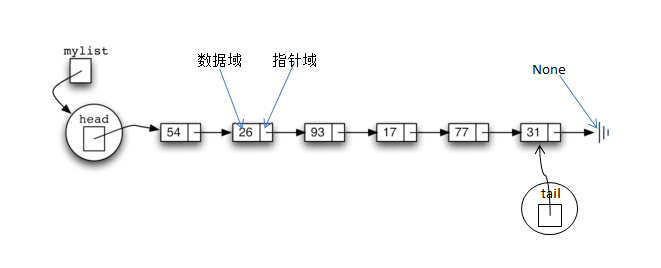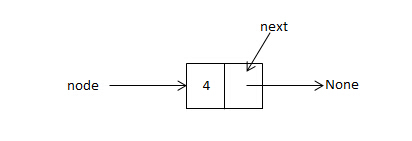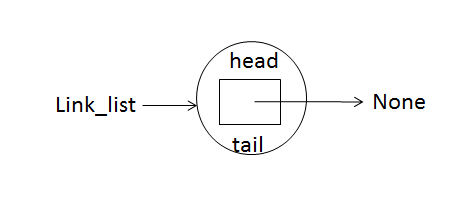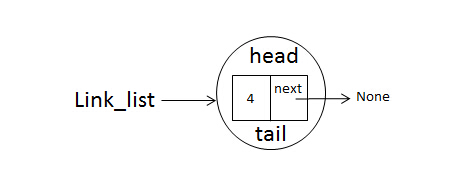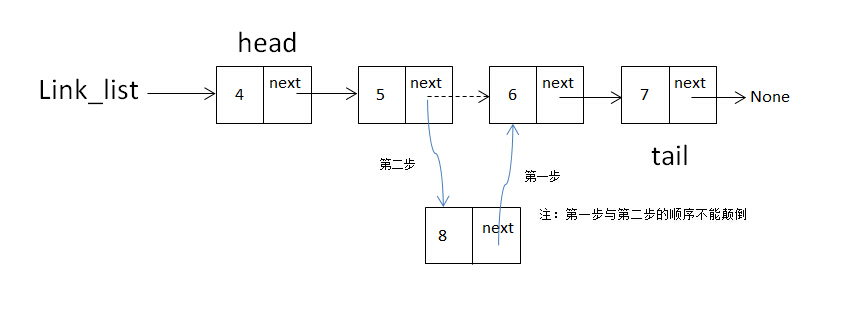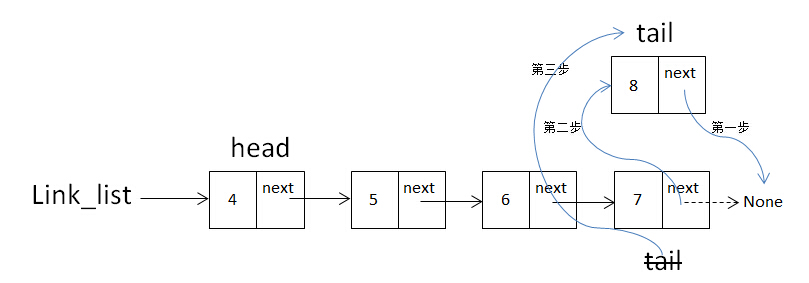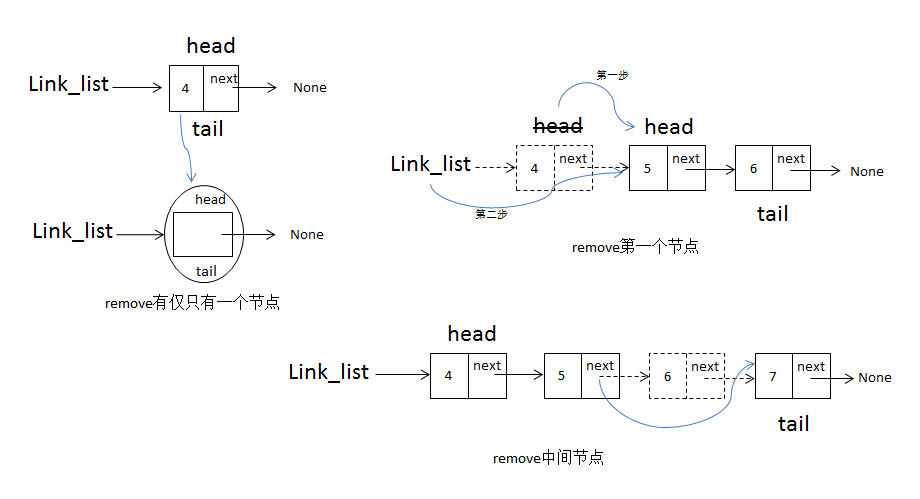数据结构-链表 转载之(http://zhaochj.github.io/2016/05/12/2016-05-12-%E6%95%B0%E6%8D%AE%E7%BB%93%E6%9E%84-%E9%93%BE%E8%A1%A8/#)
什么是链表,我对这个概念非常陌生。
链表是实现了数据之间保持逻辑顺序,但存储空间不必按顺序的方法。可以用一个图来表示这种链表的数据结构:
链表中的基本要素:
- 结点(也可以叫节点或元素),每一个结点有两个域,左边部份叫
值域,用于存放用户数据;右边叫指针域,一般是存储着到下一个元素的指针 - head结点,head是一个特殊的结节,head结点永远指向第一个结点
- tail结点,tail结点也是一个特殊的结点,tail结点永远指向最后一个节点
- None,链表中最后一个结点指针域的指针指向None值,因也叫
接地点,所以有些资料上用电气上的接地符号代表None
链表的常用方法:
- LinkedList() 创建空链表,不需要参数,返回值是空链表
- is_empty() 测试链表是否为空,不需要参数,返回值是布尔值
- append(data) 在尾部增加一个元素作为列表最后一个。参数是要追加的元素,无返回值
- iter() 遍历链表,无参数,无返回值,此方法一般是一个生成器
- insert(idx,value) 插入一个元素,参数为插入元素的索引和值
- remove(idx)移除1个元素,参数为要移除的元素或索引,并修改链表
- size() 返回链表的元素数,不需要参数,返回值是个整数
- search(item) 查找链表某元素,参数为要查找的元素或索引,返回是布尔值
节点类
python用类来实现链表的数据结构,节点(Node)是实现链表的基本模块,每个节点至少包括两个重要部分。首先,包括节点自身的数据,称为“数据域”(也叫值域)。其次,每个节点包括下一个节点的“引用”(也叫指针)
下边的代码用于实现一个Node类:
class Node(object): def __init__(self, data, next=None): self.data = data self.next = next
此节点类只有一个构建函数,接收一个数据参数,其中next表示指针域的指针,实例化后得到一个节点对象,如下:
node = Node(4)
此节点对象数据为4,指针指向None。
这样一个节点对象可以用一个图例来更形象的说明,如下:
链表类
先来看LinkedList类的构建函数:
class LinkedList(object): def __init__(self, head=None, tail=None): self.head = head self.tail = tail
此类实例后会生成一个链表对象,初始化了head和tail节点,且两节点都指向None,实例化代码如下:
link_list = LinkedList()
也可以用图形象的表示这个链表对象,如下:
is_empty方法实现
is_empty方法检查链表是否是一个空链表,这个方法只需要检查head节点是否指向None即可,代码如下:
def is_empty(self): return self.head is None
如果是空列表返回True,否则返回False
append方法实现
append方法表示增加元素到链表,这和insert方法不同,前者使新增加的元素成为链表中第一个节点,而后者是根据索引值来判断插入到链表的哪个位置。代码如下:
def append(self, data): node = Node(data) if self.head is None: self.head = node self.tail = node else: self.tail.next = node self.tail = node
既然要新增加节点,首先把Node类实例化得到一个node对象。这里有两种情况需要考虑,一是链表是一个空链表时怎样append一个节点;二是当链表不是空链表时又怎样append一个节点?
当if self.head is None:为True时,把链表的head和tail都指向了node,假如我们执行了
link_list.append(4)
此时的链表结构如下图:
当if self.head is None:为False时,说明链表已经增加了一个节点了,再增加一个节点时head已经指向了第一个节点,所以不为None,比如增加的第二个节点为:
link_list.append(5)
增加第二个节点的操作需要分两步完成,第一步:self.tail.next = node,即把上一个节点的next指针指向当前node;第二步:self.tail = node,把tail移动到node,如下图:
移动完成后就成这样了:
当增加第三个、第四个等节点时,按照上边的操作依次类推。
iter方法实现
iter方法表示遍历链表。在遍历链表时也要首先考虑空链表的情况。遍历链表时从head开始,直到一个节点的next指向None结束,代码如下:
def iter(self): if not self.head: return cur = self.head yield cur.data while cur.next: cur = cur.next yield cur.data
当是遍历一个空链表时,if not self.head:为True,直接返回None;如果不是空链表就让一个局部变量cur指向head,并把head的data属性yield出来,再对cur的next指针指向的对象做while循环,直到next指向None,这样就遍历了链表。
insert方法实现
假如采取append方法又增加了两个节点,增加完成后如下图:
如果想在数据域为6的那节点处插入一个节点,需要做的操作有两步:
- 把新节点的next指针指向数据域为
6的这个节点,即为数据域为5节点的next指向指向的对象 - 把数据域为
5节点的next指针指向新加的节点
注: 这两个步骤不能颠倒,如果颠倒,数据域为6的节点会被丢失,数据域为7的节点不再是链表的节点。
示意图如下:
还要额外考虑两种情况:
- 空链表时
- 插入位置超出链表节点的长度时
- 插入位置是链表的最后一个节点时,需要移动tail
当是在链表最后一个节点插入时,示意图如下:
要在指定的索引位置插入一个节点,前提是需要找到这个位置,在链表中只有采用遍历的方式,具有O(n)的速度,最糟糕时会遍历链表的所有节点,而当找到插入点时,我们并不需要当前节点的信息,而是需要前一个节点的信息,所以代码中巧妙的使用了while cur_idx < idx-1:的方式,这样能使用cur这个变量能指向插入点上一个节点对象。
实现insert方法的代码如下:
def insert(self, idx, value): cur = self.head cur_idx = 0 if cur is None: raise Exception('The list is an empty list') while cur_idx < idx-1: cur = cur.next if cur is None: raise Exception('list length less than index') cur_idx += 1 node = Node(value) node.next = cur.next cur.next = node if node.next is None: self.tail = node
remove方法实现
remove方法接收一个idx参数,表示要删除节点的索引,此方法要考虑以下几种情况:
- 空链表,直接抛出异常
- 删除第一个节点时,移动head到删除节点的next指针指向的对象
- 链表只有一个节点时,把head与tail都指向None即可
- 删除最后一个节点时,需要移动tail到上一个节点
- 遍历链表时要判断给定的索引是否大于链表的长度,如果大于则抛出异常信息
请看下边图例:
以下为remove函数的代码:
def remove(self, idx): cur = self.head cur_idx = 0 if self.head is None: # 空链表时 raise Exception('The list is an empty list') while cur_idx < idx-1: cur = cur.next if cur is None: raise Exception('list length less than index') cur_idx += 1 if idx == 0: # 当删除第一个节点时 self.head = cur.next cur = cur.next return if self.head is self.tail: # 当只有一个节点的链表时 self.head = None self.tail = None return cur.next = cur.next.next if cur.next is None: # 当删除的节点是链表最后一个节点时 self.tail = cur
size函数实现
size函数不接收参数,返回链表中节点的个数,要获得链表的节点个数,必定会遍历链表,直到最后一个节点的next指针指向None时链表遍历完成,遍历时可以用一个累加器来计算节点的个数,如下代码:
def size(self): current = self.head count = 0 if current is None: return 'The list is an empty list' while current is not None: count += 1 current = current.next return count
search函数实现
search函数接收一个item参数,表示查找节点中数据域的值。search函数遍历链表,每到一个节点把当前节点的data值与item作比较,最糟糕的情况下会全遍历链表。如果查找到有些数据则返回True,否则返回False,代码如下:
def search(self, item): current = self.head found = False while current is not None and not found: if current.data == item: found = True else: current = current.next return found
Node类与LinkedList类完整代码
最后把Node类和LinkedList类的完整代码整理如下:
Node类:
class Node: def __init__(self, data): self.data = data self.next = None
LinkedList类及调度代码:
class LinkedList: def __init__(self): self.head = None self.tail = None def is_empty(self): return self.head is None def append(self, data): node = Node(data) if self.head is None: self.head = node self.tail = node else: self.tail.next = node self.tail = node def iter(self): if not self.head: return cur = self.head yield cur.data while cur.next: cur = cur.next yield cur.data def insert(self, idx, value): cur = self.head cur_idx = 0 if cur is None: # 判断是否是空链表 raise Exception('The list is an empty list') while cur_idx < idx - 1: # 遍历链表 cur = cur.next if cur is None: # 判断是不是最后一个元素 raise Exception('list length less than index') cur_idx += 1 node = Node(value) node.next = cur.next cur.next = node if node.next is None: self.tail = node def remove(self, idx): cur = self.head cur_idx = 0 if self.head is None: # 空链表时 raise Exception('The list is an empty list') while cur_idx < idx - 1: cur = cur.next if cur is None: raise Exception('list length less than index') cur_idx += 1 if idx == 0: # 当删除第一个节点时 self.head = cur.next cur = cur.next return if self.head is self.tail: # 当只有一个节点的链表时 self.head = None self.tail = None return cur.next = cur.next.next if cur.next is None: # 当删除的节点是链表最后一个节点时 self.tail = cur def size(self): current = self.head count = 0 if current is None: return 'The list is an empty list' while current is not None: count += 1 current = current.next return count def search(self, item): current = self.head found = False while current is not None and not found: if current.data == item: found = True else: current = current.next return found if __name__ == '__main__': link_list = LinkedList() for i in range(150): link_list.append(i) # print(link_list.is_empty()) # link_list.insert(10, 30) # link_list.remove(0) for node in link_list.iter(): print('node is {0}'.format(node)) print(link_list.size()) # print(link_list.search(20))
